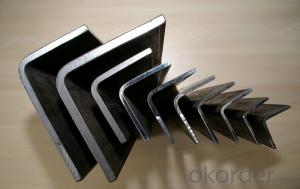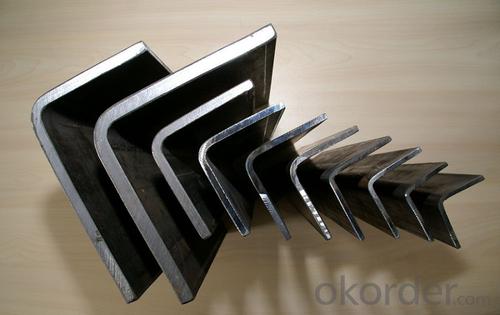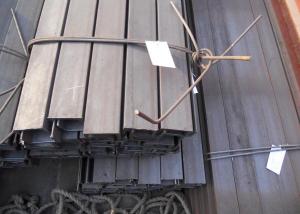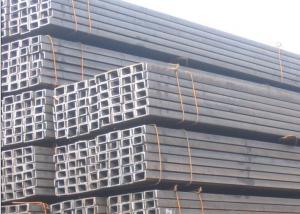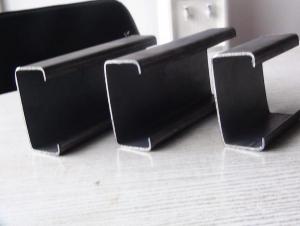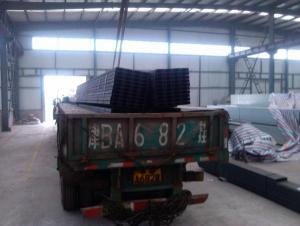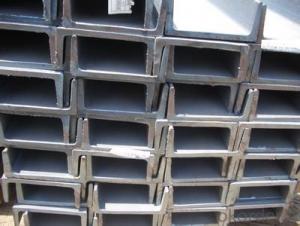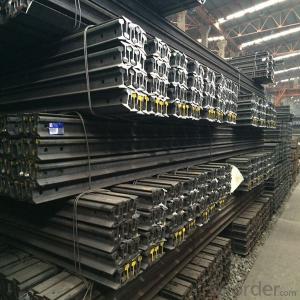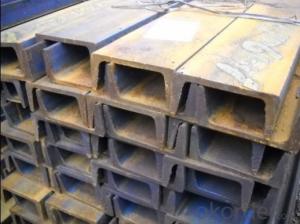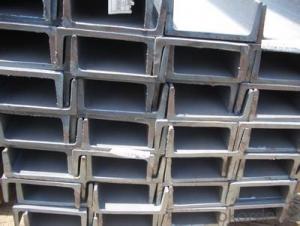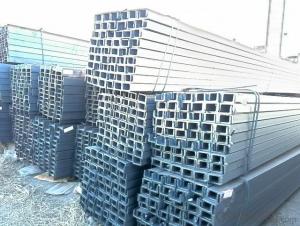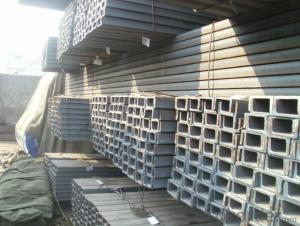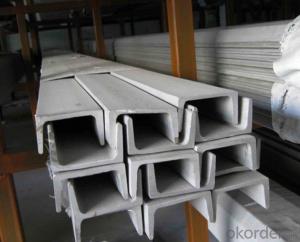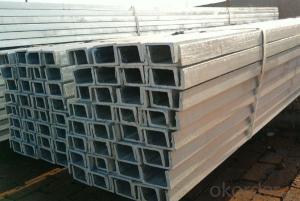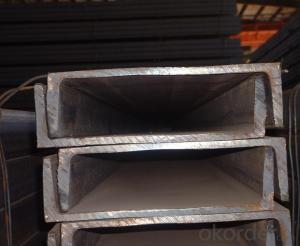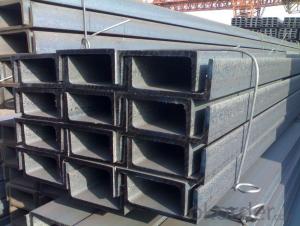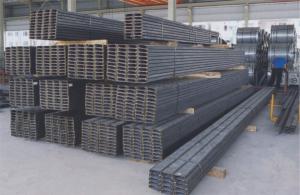JIS U CHANNEL HIGH QUALITY
- Loading Port:
- China Main Port
- Payment Terms:
- TT OR LC
- Min Order Qty:
- -
- Supply Capability:
- -
OKorder Service Pledge
OKorder Financial Service
You Might Also Like
CHANNEL Details:
| Minimum Order Quantity: | | Unit: | m.t. | Loading Port: | |
| Supply Ability: | | Payment Terms: | | Package: | wire bundle |
Product Description:
Specifications of MS Channel:
1.We supply high quality MS Channel at reasonable price, including Chinese standard, Japanese standard and so on.
Standard | GB/JIS |
Material Grade | Q235,SS400 |
Technique: | Hot Rolled |
Sizes as per chinese standard: | 50*37*4.5mm - 300*89*11.5mm |
Sizes as per japanese standard: | 50*25*3mm – 200*80*7.5mm |
Length: | 6meter, 9meter, 12meter |
Note: 1.we are also competent to provide our customers other MS Channel based on other sizes according to customer’s requirements.
2. The length of our ms channel could be cut into other meters as per customer’s requirements. For example, the channel in 6meters could be cut into 5.8meters in order to be fit in the 20ft container.
2. The detailed sections of MS Channel as per GB standard.are shown in the table-1:
GB U CHANNEL | Standard | Sectional | Dimension |
| Mass: |
| (mm) | (mm) | (mm) | (mm) |
|
50X37 | 50 | 37 | 4.50 | 7.0 | 5.438 |
63X40 | 63 | 40 | 4.80 | 7.5 | 6.634 |
80x43 | 80 | 43 | 5.00 | 8.0 | 8.045 |
|
|
|
|
|
|
100x48 | 100 | 48 | 5.30 | 8.5 | 10.007 |
120x53 | 120 | 53 | 5.50 | 9.0 | 12.059 |
140x58 | 140 | 58 | 6.00 | 9.5 | 14.535 |
140x60 | 140 | 60 | 8.00 | 9.5 | 16.733 |
|
|
|
|
|
|
160x63 | 160 | 63 | 6.50 | 10.0 | 17.240 |
160x65 | 160 | 65 | 8.50 | 10.0 | 19.752 |
|
|
|
|
|
|
180x68 | 180 | 68 | 7.00 | 10.5 | 20.174 |
180x70 | 180 | 70 | 9.00 | 10.5 | 23.000 |
|
|
|
|
|
|
200x73 | 200 | 73 | 7.00 | 11.0 | 22.637 |
200x75 | 200 | 75 | 9.00 | 11.0 | 25.777 |
|
|
|
|
|
|
220x77 | 220 | 77 | 7.00 | 11.5 | 24.999 |
220x79 | 220 | 79 | 9.00 | 11.5 | 28.453 |
|
|
|
|
|
|
250x78 | 250 | 78 | 7.00 | 12.0 | 27.410 |
250x80 | 250 | 80 | 9.00 | 12.0 | 31.335 |
250x82 | 250 | 82 | 11.00 | 12.0 | 35.260 |
|
| |
|
|
|
280x82 | 280 | 82 | 7.50 | 12.5 | 31.427 |
280x84 | 280 | 84 | 9.50 | 12.5 | 35.823 |
280x86 | 280 | 86 | 11.50 | 12.5 | 40.219 |
|
|
|
|
|
|
300x85 | 300 | 85 | 7.50 | 13.5 | 34.463 |
300x87 | 300 | 87 | 9.50 | 13.5 | 39.173 |
300x89 | 300 | 89 | 11.50 | 13.5 | 43.883 |
Table-1
3. The chemical composition of HR Channel Steel according to Q235B is shown in Table-2.
Alloy No | Grade | Element(%) | ||||
C | Mn | S | P | Si | ||
Q235 | B | 0.12-0.20 | 0.3-0.7 | ≦0.045 | ≦0.045 | ≦0.3 |
Table-2
Note: we are able to present our customers relevant SGS test report for chemical composition of HR Channel Steel.
4. The mechanical property of HR Channel Steel according to Q235B is shown in Table-3-1 and Table-3-2
Alloy No | Grade | Yielding Strength Point(Mpa) | |||
Thickness(mm) | |||||
≦16 | >16-40 | >40-60 | >60-100 | ||
≧ | |||||
Q235 | B | 235 | 225 | 215 | 205 |
Table-3-1
Alloy No | Grade | Tensile Strength(Mpa) | Elongation After Fracture(%) | |||
| | Thickness(mm) | |||||
≦16 | >16-40 | >40-60 | >60-100 | |||
≧ | ||||||
G235 | B | 375-500 | 26 | 25 | 24 | 23 |
Table-3-2
Note: we are able to present our customers relevant SGS test report for mechanical property of MS Channel as customer’s request.
Applications of MS Channel:
The MS Channel can be applied to construction of warehouses, workshops, sport stadiums and car parks etc.The hot rolled channel steel belongs to carbon structural steel which is applied to in the field of construction and machinery.In details, the hot rolled channel steel is usually used for arch-itechtural structure, and they could be welded in order to support or hang a vari-ety of facilities. They are also usually used in combination with I beam. Generally,the hot rolled channel steel we supply must possess perfect welding property, riveting property and mechanical property and so on.
Package & Delivery of MS Channel:
1.The hot rolled channel steel will be packed in bundle with steel wire at each end of every bundle and color marking in order to help the customer to recognize his goods more easily at sight.
2. And the hot rolled channel steel could be loaded into 20ft or 40ft container, or by bulk cargo.If the weight of each bundle reaches more than 3.5 mt, the loading by break bulk cargo should be choosed.When the weight of each bundle reaches less than 3mt, the loading by container should be choosed.
3.As for the transportaion from mill to loading port, the truck will be usually used. And the maximum quantity for each truck is 40mt.
4.All in all, we could do in accordance with customer's request
- Q: How do steel channels contribute to the stability of crane runways?
- The stability of crane runways is enhanced by steel channels in multiple ways. Firstly, these channels provide a robust and rigid support structure for the crane to operate on. Typically constructed from high-quality steel, known for its durability and ability to bear heavy loads, they ensure that the crane runway can withstand the weight and dynamic loads imposed during operation. In addition, steel channels are designed to evenly distribute the load across the supporting beams or columns. This prevents concentrated stress points and spreads the load over a larger area, reducing the risk of structural failure or collapse. By effectively distributing the load, steel channels maintain the stability of the crane runway, even when subjected to heavy loads or sudden movements. Another significant role of steel channels in crane runways is their capacity to withstand lateral forces. These forces may arise from wind, uneven loading, or sudden changes in direction as the crane moves along the runway. Steel channels provide a strong framework that effectively resists these lateral forces, preventing excessive deflection or sway in the runway structure. This is vital for maintaining the stability and safety of the crane during operation. Furthermore, steel channels are easily fabricated and installed, allowing for efficient construction of crane runways. They can be customized to meet the specific requirements of the crane and the site, ensuring a precise fit and optimal performance. The versatility of steel channels also allows for various configurations and layouts, making it possible to design crane runways that can accommodate different crane sizes and load capacities. In conclusion, steel channels play a crucial role in ensuring the stability of crane runways. Their strength, load-bearing capacity, and ability to distribute loads evenly contribute to the overall structural integrity of the runway. Additionally, their resistance to lateral forces and ease of installation make them an excellent choice for constructing reliable and safe crane runways.
- Q: Do steel channels have any specific safety considerations?
- Yes, steel channels have specific safety considerations that need to be taken into account. These include ensuring proper installation to prevent structural failure, regular inspection for signs of corrosion or damage, and implementing appropriate measures to prevent trips, slips, and falls when working around or on steel channels.
- Q: What are the lengths of the channel factory?
- Channel steel is a kind of carbon structural steel used for construction and machinery. It is a complex section steel. Its cross section has a groove shape. Channel steel is mainly used in building structure, curtain wall engineering, mechanical equipment and vehicle manufacturing, etc..
- Q: How are steel channels used in construction?
- Steel channels are widely used in construction for various purposes. One of the primary uses of steel channels is in structural applications, where they are used to provide support and stability to a building's framework. They are often used as beams or columns to bear heavy loads and resist bending or twisting forces. Steel channels are also commonly used for framing and framing accessories, such as door and window frames. They provide a rigid and durable framework for installing doors, windows, and other fixtures. In addition, steel channels are utilized in the construction of ceilings, walls, and partitions. They can be used as support elements for attaching drywall or other finishing materials, providing strength and stability to the overall structure. Furthermore, steel channels are employed in the construction of infrastructure projects such as bridges and highways. They serve as structural components that can withstand heavy loads and provide the necessary strength and durability required for these types of constructions. Overall, steel channels are indispensable in construction due to their strength, versatility, and durability. They play a crucial role in ensuring the stability and structural integrity of buildings, making them a vital component in the construction industry.
- Q: Are steel channels cost-effective compared to other materials?
- Steel channels are generally considered to be a cost-effective option when compared to other materials. This is due to the fact that steel is widely available and relatively inexpensive. As a result, steel channels are often chosen for construction and manufacturing projects as they provide good value for money. Not only that, but steel channels also offer exceptional strength and durability, enabling them to withstand heavy loads and harsh conditions. This durability leads to long-term cost savings, as steel channels require less maintenance and replacement compared to alternative materials. Moreover, steel is highly recyclable, making it an environmentally friendly choice. Although the initial cost of steel channels may be slightly higher than some other materials, their long-term cost-effectiveness and numerous benefits make them a popular option in various industries.
- Q: What is the difference between hot-rolled and cold-formed steel channels?
- The main difference between hot-rolled and cold-formed steel channels lies in the manufacturing process. Hot-rolled steel channels are formed by heating the steel billet to high temperatures and then rolling it into the desired shape. This method results in a more uniform grain structure and higher strength compared to cold-formed steel channels. On the other hand, cold-formed steel channels are created by bending or rolling steel sheets at room temperature. This process is more cost-effective and allows for greater design flexibility, but the resulting channels may have a less consistent grain structure and slightly lower strength.
- Q: What does channel 20# mean?.
- 20# channel steel means that the middle width is 200mm. There are two kinds of specifications: A and B: 20#A:200*73*7, 20#B:200*75*9, sizes indicate middle width * leg width * middle thickness.
- Q: What are the different methods for transporting and handling steel channels?
- There are several methods for transporting and handling steel channels, including the use of forklifts, cranes, overhead lifting devices, and manual labor. Forklifts are commonly used for moving and transporting steel channels within a facility or loading them onto trucks for transportation. Cranes are used for lifting and moving heavier or larger steel channels, especially in construction sites. Overhead lifting devices, such as hoists or slings, can also be used to handle steel channels. Additionally, manual labor can be employed for smaller or lighter steel channels, where workers can manually carry or push them into place. The specific method chosen depends on the size, weight, and location of the steel channels, as well as the available equipment and resources.
- Q: What are the different methods of surface treatment for steel channels?
- The different methods of surface treatment for steel channels include painting, galvanizing, powder coating, and electroplating.
- Q: What are the different surface treatments for steel channels?
- Steel channels have various surface treatments available, each serving a specific purpose and offering distinct advantages. Examples of common treatments include: 1. Hot-dip galvanizing, where the steel channel is immersed in molten zinc, resulting in a durable coating that provides excellent corrosion resistance. This treatment is ideal for outdoor applications and environments with high humidity or exposure to harsh chemicals. 2. Powder coating involves applying a dry powder to the steel channel's surface, which is then cured under heat to form a protective layer. This treatment offers a wide range of color options, enhances aesthetics, and provides good resistance against corrosion, abrasion, and UV damage. 3. Electroplating deposits a thin layer of metal, like zinc or chromium, onto the steel channel's surface using an electric current. This treatment improves the channel's appearance, corrosion resistance, and can impart specific properties like increased hardness or conductivity. 4. Paint coating involves applying paint to the steel channel, offering both aesthetic appeal and protection against corrosion. Paint coatings come in various colors and application techniques, such as spraying or brushing. However, they may not be as long-lasting as other treatments and may require periodic maintenance. 5. Anodizing, primarily used for aluminum channels but also applicable to steel channels, creates an oxide layer on the surface through an electrochemical process. This treatment enhances corrosion resistance and provides a decorative finish, commonly used in architectural applications. When selecting the most suitable surface treatment for steel channels, it is vital to consider factors such as the intended use, environmental conditions, and desired aesthetics. Seeking advice from professionals or experienced suppliers in steel treatments can help determine the optimal option for specific requirements.
Send your message to us
JIS U CHANNEL HIGH QUALITY
- Loading Port:
- China Main Port
- Payment Terms:
- TT OR LC
- Min Order Qty:
- -
- Supply Capability:
- -
OKorder Service Pledge
OKorder Financial Service
Similar products
Hot products
Hot Searches
Related keywords
